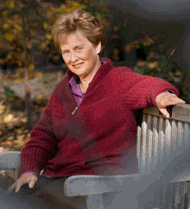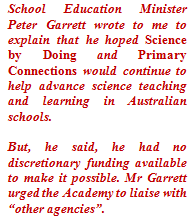
When the President of the Australian Academy of Science Speaks, Who Listens?

Suzanne Cory
|
Editorial
- 01 October 2011 |
|
|
When the President of the Australian Academy of Science Speaks, Who Listens? |
|
The president of the Australian Academy of Science (AAS),
Professor Suzanne Cory,
addressed the National Press Club![]() this past Wednesday.
That same day The Conversation published an opinion piece by her, "Science,
maths and the future of Australia" in which she makes it clear that the views
expressed by her are in her capacity as president of the AAS. Both are important
contributions because they portray in bold strokes that "Australia faces many
big challenges -- in the economy, health, energy, water, climate change,
infrastructure, sustainable agriculture and the preservation of our precious
biodiversity. To meet these, we need creative scientists and engineers drawn
from many disciplines, and a technologically-skilled workforce."
this past Wednesday.
That same day The Conversation published an opinion piece by her, "Science,
maths and the future of Australia" in which she makes it clear that the views
expressed by her are in her capacity as president of the AAS. Both are important
contributions because they portray in bold strokes that "Australia faces many
big challenges -- in the economy, health, energy, water, climate change,
infrastructure, sustainable agriculture and the preservation of our precious
biodiversity. To meet these, we need creative scientists and engineers drawn
from many disciplines, and a technologically-skilled workforce."
After noting a number of significant contributions that have been made through Australian research, innovation and development in the past, and that the current Labor government has increased a total investment in research and innovation by almost 43 %, and is projected to amount to 9.4 billion dollars over the current financial year the AAS president made the point that:
...our ability to improve [on past] performance in the
future, or even maintain it, is not assured:
Four things threaten our ongoing R&D performance and, as a consequence, our
economic security and ongoing prosperity:
The level of our investment in research and development
Our capacity to lever this investment by engaging effectively with the global science effort
The poor science literacy of our workforce and our community
The decline of interest in science education in our schools.
So, for example in comparison with our OECD cohort "Australia ranks 14th for Business Expenditure on R&D as % of GDP". Furthermore, "Australia spends around 2.2% of our gross domestic product – or around $900 per person per year – on research and development. This puts us at a rank of 14th among OECD member countries. We are well behind the next best-ranked country, Iceland – which devotes 2.6% of GDP to research and development. Top of the list is Israel, with 4.6%, followed by Finland and Sweden, each of which spend 3.6% -- Canada is at 1.87% and rank is 17th ".
And then to ram home the point: "Worryingly, we rank well within the bottom half of OECD countries (ranked 20th of 30) when it comes to the number of university graduates emerging with a science or engineering degree per capita. Research excellence is a precious entity that requires constant tending and nurturing [but]...costs are rising faster than the level of funding, and career opportunities are limited, despite recent government initiatives to improve them.
To be quite frank, we need much greater investment in science in this country, by government – both State and Federal – and by business... We would not have had any of our mining booms if our geology had not mapped by Government Geological Surveys, at great public expense, starting in 1850.
Professor Cory then made this plea: The Australian Academy of Science therefore calls on the Government to create a Sovereign Fund for Science, to secure the future prosperity of the nation. The goal should be to increase Australia’s research and development expenditure to at least 3% of GDP by 2020 (her emphasis).
Turning to the matter of international collaborations Professor Cory told the National Press Club:
Australia produces only 2% of the world's knowledge. To
gain access to the other 98%, we must ensure that our scientists are
well-connected internationally.
Being part of big international programs opens up horizons that would be
inconceivable for Australian Science going it alone.
The importance of staying connected internationally is well-appreciated by our
science funding agencies and successive Science and Health Ministers.
Today many grants, and fellowships provided by the Australian Research Council,
National Health and Medical Research Council and CSIRO support projects that
include international partners.
Many of these linkages were initially catalysed by the federal government's
International Science Linkages or ISL program.
One of ISL.s most fertile activities was its sponsorship of bilateral workshops,
symposia and research exchange programs with the US, Europe, China, Japan, Korea
and Singapore.
Regrettably, the 10-year International Science Linkages program ended in June
2011. Funding was not renewed in the 2011-2012 Budget.
I strongly urge the Federal Government to fund in its next Budget a new program
to provide strategic support for Australia’s International Science Linkages.
With regard to Australia's future workforce requirements, Professor Cory observed:
There is broad consensus among minds more economically astute than mine that our future prosperity will depend upon... the creation of the kind of knowledge-intensive goods and services that can only result from robust research and development," she then noted: "This year the Australian-born head of Dow Chemical, Andrew Liveris, published a blueprint for the future of manufacturing in Western economies. It leans heavily upon the deployment of science, engineering and intellectual capacity to revive manufacturing. If we do not equip [our] students with the right skills, we will find ourselves in the near future with a very lacklustre economy and a dangerous paucity of skilled workers.
It is essential that we act now to break the bottleneck and put in place measures that will create the technologically competent workforce we need for the future, [and place] appropriate emphasis on properly educating our young people in the areas of science, maths and technology.
And finally there is the matter of the state of science and maths education.
Without a robust and inspiring science and maths education system, it is impossible to create an internationally competitive workforce.
...We need to harness the natural
curiosity [of children] and nurture it with inspiring education, [but] Australian public
expenditure on education as a percentage of Gross Domestic Product is just 4.2%
– significantly below the OECD average of 5.4%.
percentage of Gross Domestic Product is just 4.2%
– significantly below the OECD average of 5.4%.
Today, student disenchantment with science continues. This is all too apparent from the declining number of students who choose to study science in senior secondary school. In 1991, more than 1/3 of Year 12 students chose to study biology. Now, that has dropped to less than 1/4. 23% of Year 12 students studied chemistry ten years ago, compared with 18% now. And in the same period, physics has fallen from 21% to 14%.
Australia's early secondary mathematical literacy scores have significantly declined over the last decade and our Year 4 and Year 8 students ranked only 14th internationally in the most recent Trends International Mathematics and Science Study, conducted in 2007.
Without maths it is not possible to make use of other sciences – either in the lab or in the workforce.
Scientific issues pervade an enormous range of the decisions we make. Major national decisions are rightly taken by parliament, but they should be informed by public input and robust debate. And where science is involved, public input and debate must be based on understanding and scientific evidence, not on misinformation and uninformed assumption... It is very evident therefore that modern society needs to be scientifically literate.
...our Government is already investing significantly in school infrastructure
and in rolling out a national high speed internet network.
Last December education ministers approved the content for new national
curricula in English, history, maths and science. In coming months, they will be
asked to sign off on the standards for these curricula. This is an important
initiative and the Academy of Science applauds it.
But further investment is needed to ensure that it is properly implemented: Investment in teachers, and in inspiring curriculum programs. Inspired (and inspiring) teachers will be the most important agents for improving educational outcomes. (our emphasis).
We must place a much higher societal value on teachers and do everything we can to recruit some of our brightest and best into teaching. We must support these educators with the best tools and resources available and provide them with stimulating opportunities for ongoing training.
I want [now] to focus on two most the Academy's recent science education programs: Primary Connections, for primary school; and Science by Doing, for junior secondary school. Both have received substantial funding and support from the Federal Government. ...Both of these programs are designed to invigorate science teaching. They enhance teachers' skills and emphasise engaging, inquiry-based approaches to guide and enthuse children's learning.
School Education Minister Peter Garrett wrote to me to explain that he hoped Science by Doing and Primary Connections would continue to help advance science teaching and learning in Australian schools.
But, he said, he had no discretionary funding available to make it possible. Mr Garrett urged the Academy to liaise with “other agencies”.
We believe all Australian students deserve access to such proven, quality programs. And so, even though it will take us longer and may not be able to be delivered equitably across Australian schools, the Academy is committed to rolling out Primary Connections and Science by Doing at cost price.
Alex Reisner
The Funneled Web